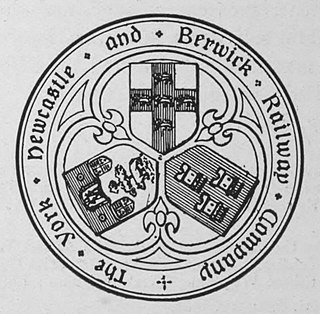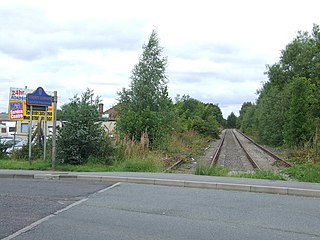
The Eden Valley Railway (EVR) was a railway in Cumbria, England. It ran between Clifton Junction near Penrith and Kirkby Stephen via Appleby-in-Westmorland.

The Durham Coast Line is an approximately 39.5-mile (63.6 km) railway line running between Newcastle and Middlesbrough in North East England. Heavy rail passenger services, predominantly operated Northern Trains, and some freight services operate over the whole length of the line; it provides an important diversionary route at times when the East Coast Main Line is closed. Light rail services of the Tyne and Wear Metro's Green Line also operate over the same tracks between a junction just south of Sunderland station and Pelaw Junction.

Durham is a railway station on the East Coast Main Line, which runs between London King's Cross and Edinburgh Waverley. The station, situated 14 miles 3 chains south of Newcastle, serves the cathedral city of Durham in County Durham, England. It is owned by Network Rail and managed by London North Eastern Railway.

The Leamside Line, originally part of the Durham Junction Railway, is a disused railway line, located in the North East of England. The alignment diverges from the East Coast Main Line at Tursdale Junction, travelling a distance of 21 miles north through the Durham Coalfield and Washington, prior to joining the Durham Coast Line at Pelaw Junction. The Leamside Line closed to passenger traffic in 1964, under the Beeching cuts.

Pelaw is a Tyne and Wear Metro station, serving the suburbs of Bill Quay, Pelaw and Wardley, Gateshead in Tyne and Wear, England. It joined the network on 15 September 1985.

Bishop Auckland is a railway station that serves the market town of Bishop Auckland in County Durham, North East England, 11 miles 77 chains (19.3 km) north-west of Darlington. The station is the Western terminus of the Tees Valley Line, which links it to Saltburn via Darlington. It is owned by Network Rail and managed by Northern Trains.
The Stanhope and Tyne Railway was an early British mineral railway, that ran from Stanhope in County Durham, to South Shields at the mouth of the River Tyne. The object was to convey limestone from Stanhope and coal from West Consett and elsewhere to the Tyne, and to local consumers. Passengers were later carried on parts of the line.

The York, Newcastle and Berwick Railway (YN&BR) was an English railway company formed in 1847 by the amalgamation of the York and Newcastle Railway and the Newcastle and Berwick Railway. Both companies were part of the group of business interests controlled by George Hudson, the so-called Railway King. In collaboration with the York and North Midland Railway and other lines he controlled, he planned that the YN&BR would form the major part of a continuous railway between London and Edinburgh. At this stage the London terminal was Euston Square and the route was through Normanton. This was the genesis of the East Coast Main Line, but much remained to be done before the present-day route was formed, and the London terminus was altered to King's Cross.
Gateshead railway station served the town of Gateshead, England between 1844 and 1981. It was situated on the northern and western sides of the triangular junction to the south of the High Level Bridge which connects Gateshead with Newcastle upon Tyne. There were two portions to the station on different routes; at times they were known as Gateshead East and Gateshead West.

Ferryhill was a railway station located in Ferryhill in County Durham, Northeast England. It was located on what became the East Coast Main Line between Darlington and Durham, close to the junctions with several former branches, including the extant freight-only Stillington Line to Norton-on-Tees and Stockton.
Crook railway station served the town of Crook, County Durham, England. It was located on the Bishop Auckland and Weardale Railway line from Bishop Auckland to Blackhill between Wear Valley Junction and Tow Law, 17 miles (27 km) north west of Darlington.

Penshaw railway station served the village of Penshaw, Tyne and Wear, England from 1840 to 1964 on the Leamside line.

Leamside railway station served the villages of Leamside and West Rainton, in County Durham, England from 1844 to 1953 on the Leamside line.

Washington railway station served the town of Washington, Tyne and Wear, England from 1835 to 1963, initially on the Stanhope & Tyne Railway and later the Leamside line.

Fencehouses railway station served the village of Fencehouses, Tyne and Wear, England from 1841 to 1964 on the Leamside line.

Sherburn Colliery railway station served the village of Sherburn, County Durham, England from 1844 to 1959 on the Leamside line.

Wellfield railway station was a railway station built by the North Eastern Railway (NER) on the route of the Hartlepool Dock & Railway (HD&R) to allow interchange between the existing line and their newly opened line from Stockton-on-Tees which had opened to passenger traffic just two years earlier. When first built, the station was located in a rural area, being located immediately to the north of the bridge carrying the Durham to Hartlepool road over the railway line. However the village of Wingate in County Durham, North East England gradually expanded northwards over the course of the station's life and as a result, the station became one of two to serve the village. It was also located only a relatively short distance from the Castle Eden Brewery and thus served the northern district of Castle Eden that surrounds it.

Durham (Gilesgate) railway station served the Gilesgate area of Durham City in County Durham, North East England from 1844 to 1857 as the terminus of the Newcastle & Darlington Junction Railway Durham Branch passenger service. Its life as a passenger station was short and it was quickly converted to goods station, a role which it played for more than a century.

Ryhoperailway station was one of two railway stations to have served the village of Ryhope, Tyne & Wear. For much of its existence, it was served by the Durham–Sunderland and Hartlepool–Haswell–Sunderland lines.
Rainton railway station briefly served the village of West Rainton, County Durham, England, in 1844 on the Leamside Line.
















